Research on Critical Factors Influencing Organizational Resilience of Major Transportation Infrastructure Projects: A Hybrid Fuzzy DEMATEL-ISM-MICMAC Approach
Abstract
:1. Introduction
- (1)
- Investigate and figure out the relevant factors affecting the organizational resilience construction of MTIPs.
- (2)
- Adopt a hybrid fuzzy DEMATEL-ISM-MICMAC methodology to analyze the importance level of influencing factors, and to study in depth the hierarchical relationship, the path of action, and the driving dependency attributes among the influencing factors.
2. Literature Review
2.1. Connotations of Organizational Resilience
2.2. Organizational Resilience Influencing Factors
2.3. Research Methodology for Influencing Factors
3. Materials and Methods
3.1. Organizational Resilience Framework for MTIPs
3.2. Identification of Influencing Factors
3.3. Methodology
3.4. Organization Resilience Influencing Factor Modeling
- (1)
- Normalize the triangular fuzzy numbers.where , , and denote the normalized values of the triangular fuzzy numbers for the left-hand side value , the middle value , and the right-hand-side value , respectively. , denotes the value of the gap between the right-hand side value and the left-hand-side value.
- (2)
- Normalization of left-hand-side and right-hand-side valueswhere , are the normalized values of the left-hand-side and right-hand-side values, respectively.
- (3)
- Calculation of crips values
- (4)
- Calculate the average of the crips values to obtain the direct impact matrix .
4. Results
4.1. Data Collection
4.2. Analysis of Fuzzy DEMATEL Results
4.2.1. Analysis of Centrality and Causality
4.2.2. Analysis of Influence Degree and Affected Degree
4.3. Analysis of ISM Results
4.4. Analysis of MICMAC Results
5. Discussion
6. Conclusions
- (1)
- Literature analysis method and case study method are used to establish the index system of organizational resilience influencing factors of MTIPs by combining the characteristic elements of resilience (stability, redundancy, rapidity, and adaptability) and project organizational subsystems (organizational system, management system, environmental system, and material and technological system).
- (2)
- Organizational resilience-influencing factors were analyzed using the fuzzy DEMATEL method. The results of the analysis show that risk prediction and warning, human resource management, inter-organizational synergy, resource reserve situation, organizational leadership, and organizational learning have a higher degree of centrality and have the greatest contribution and importance to the project organizational resilience system. Therefore, project organizations should focus on the above important influencing factors from the dynamic evolution stage of organizational resilience when enhancing resilience.
- (3)
- ISM analysis shows that risk prediction and warning, equipment condition and performance, human resource management, and organizational leadership are the fundamental factors affecting the project’s organizational resilience. The above factors belong to the organizational system, management system, and material and technical system, respectively, which indicates that in the process of construction of MTIPs, it is necessary to construct the project system in an all-round, comprehensive, and multi-level way to ensure the smooth implementation of the project.
- (4)
- The MICMAC analysis found that risk prediction and warning, equipment condition and performance, human resource management, resource reserve situation, and organizational leadership have strong drivers and low dependency and are classified as independent factors, which can be considered foundational factors to drive the development of other factors. The findings of this paper can inform the optimization of organizational resilience in MTIPs.
Author Contributions
Funding
Data Availability Statement
Acknowledgments
Conflicts of Interest
References
- Liu, N.N.; Zhou, G.H. Research on the benefit distribution and innovation incentive mechanism of multi-subject collaborative cooperation in major projects. Ind. Eng. Manag. 2023, 28, 148–155. [Google Scholar]
- Sheng, Z.H.; Xue, X.L. Constructing the Theoretical System and Discourse System of Major Project Management with Chinese Characteristics. Manag. World 2019, 35, 2–16+51+195. [Google Scholar]
- Wu, J.J.; Lv, Y. Management science and engineering research under global changes. China Manag. Sci. 2022, 30, 21–26. [Google Scholar]
- Chen, Z.; Li, X.D.; Zhu, W.N.; Wei, G. Embodied carbon emissions and mitigation potential in China’s building sector: An outlook to 2060. Energy Policy 2022, 170, 113222. [Google Scholar]
- Wang, D.D.; Zhao, X.R.; Zhang, K.N. Factors affecting organizational resilience in megaprojects: A leader–employee perspective. Eng. Constr. Archit. Manag. 2023, 30, 4590–4608. [Google Scholar] [CrossRef]
- Khalil, R. Project resilience: A conceptual framework. Int. J. Inf. Syst. Proj. Manag. 2019, 7, 69–83. [Google Scholar]
- Tierney, K.J. Structure and process in the study of disaster resilience. In Proceedings of the 14th World Conference on Earthquake Engineering, Beijing, China, 12–17 October 2008. [Google Scholar]
- Holling, C.S. Resilience and stability of ecological systems. Annu. Rev. Ecol. Syst. 1973, 4, 1–23. [Google Scholar] [CrossRef]
- Yodo, N.; Wang, P. Engineering resilience quantification and system design implications: A literature survey. J. Mech. Des. 2016, 138, 111408. [Google Scholar] [CrossRef]
- Meyer, A.D. Adapting to environmental jolts. Adm. Sci. Q. 1982, 27, 515–537. [Google Scholar] [CrossRef]
- Walker, B.; Holling, C.S.; Carpenter, S.R.; Kinzig, A. Resilience, adaptability and transformability in social-ecological systems. Ecol. Soc. 2004, 9, 5. [Google Scholar] [CrossRef]
- Duchek, S. Organizational resilience: A capability-based conceptualization. Bus. Res. 2020, 13, 215–246. [Google Scholar] [CrossRef]
- Williams, T.A.; Shepherd, D.A. Building resilience or providing sustenance: Different paths of emergent ventures in the aftermath of the Haiti earthquake. Acad. Manag. J. 2016, 59, 2069–2102. [Google Scholar] [CrossRef]
- Li, G.J.; Kou, C.H.; Wang, Y.S.; Yang, H.T. System dynamics modelling for improving urban resilience in Beijing, China. Resour. Conserv. Recycl. 2020, 161, 104954. [Google Scholar] [CrossRef]
- Fang, C.; Chu, Y.Z.; Fu, H.R.; Fang, Y.P. On the resilience assessment of complementary transportation networks under natural hazards. Transp. Res. Part D 2022, 109, 103331. [Google Scholar] [CrossRef]
- Simmie, J.; Martin, R. The economic resilience of regions: Towards an evolutionary approach. Camb. J. Reg. Econ. Soc. 2010, 3, 27–43. [Google Scholar] [CrossRef]
- Naderpajouh, N.; Yu, D.J.; Aldrich, D.P.; Linkov, I.; Matinheikki, J. Engineering meets institutions: An interdisciplinary approach to the management of resilience. Environ. Syst. Decis. 2018, 38, 306–317. [Google Scholar] [CrossRef]
- Horne, J.F.; Orr, J.E. Assessing behaviors that create resilient organizations. Employ. Relat. Today 1997, 24, 29–39. [Google Scholar]
- Lengnick-Hall, C.A.; Beck, T.E.; Lengnick-Hall, M.L. Developing a capacity for organizational resilience through strategic human resource management. Hum. Resour. Manag. Rev. 2011, 21, 243–255. [Google Scholar] [CrossRef]
- Aguila, J.O.; ElMaraghy, W. Supply chain resilience and structure: An evaluation framework. Procedia Manuf. 2019, 28, 43–50. [Google Scholar] [CrossRef]
- Garg, T.; Shrigiriwar, A.; Garg, V. Developing a Culture of Organizational Resilience. J. Am. Coll. Radiol. 2019, 16, 1363. [Google Scholar] [CrossRef]
- Sajko, M.; Boone, C.; Buyl, T. CEO greed, corporate social responsibility, and organizational resilience to systemic shocks. J. Manag. 2021, 47, 957–992. [Google Scholar] [CrossRef]
- Xu, G.N.; Wang, Y.M.; Zhou, Y. Research on the influence mechanism of organizational resilience on enterprise survival and growth in the perspective of innovation ecosystem. Sci. Sci. Technol. Manag. 2023, 1–21. [Google Scholar]
- Bothello, J.; Salles-Djelic, M.L. Evolving conceptualizations of organizational environmentalism: A path generation account. Organ. Stud. 2018, 39, 93–119. [Google Scholar] [CrossRef]
- Li, S.S.; Huang, Q.H. Research on the cultivation mode of organizational resilience of entrepreneurial enterprises under the perspective of organizational adaptation theory. Contemp. Financ. Econ. 2023, 83–94. [Google Scholar] [CrossRef]
- Tang, C.Y.; Shi, Y.Z.; Li, Y.B.; Chen, W.M. Failure to learn and firm performance: The role of organizational resilience and environmental dynamics. Manag. Rev. 2023, 35, 291–302. [Google Scholar]
- Barasa, E.; Mbau, R.; Gilson, L. What Is Resilience and How Can It Be Nurtured? A Systematic Review of Empirical Literature on Organizational Resilience. Int. J. Health Policy Manag. 2018, 7, 491–503. [Google Scholar] [CrossRef] [PubMed]
- Liu, Y.Q.; Chen, R.J.; Zhou, F.; Zhang, S.; Wang, J. Analysis of the Influencing Factors of Organizational Resilience in the ISM Framework: An Exploratory Study Based on Multiple Cases. Sustainability 2021, 13, 13492. [Google Scholar] [CrossRef]
- Bustinza, O.F.; Vendrell, H.F.; Perez, A.M.; Parry, G. Technological Capabilities, Resilience Capabilities and Organizational Effectiveness. Int. J. Hum. Resour. Manag. 2019, 30, 1370–1392. [Google Scholar] [CrossRef]
- Yamauchi, N.; Sato, H. The relationship between top management team diversity and organizational resilience: Evidence from the automotive industry in Japan. J. Gen. Manag. 2023, 48, 184–194. [Google Scholar] [CrossRef]
- Chen, C.; Yang, Z.W.; Wang, B.B.; Luo, M. Resilient leadership: Validation of multidimensional constructs, measures, and effects of organizational resilience. Manag. Sci. 2023, 36, 51–65. [Google Scholar]
- Förster, C.; Füreder, N.; Hertelendy, A. Why time matters when it comes to resilience: How the duration of crisis affects resilience of healthcare and public health leaders. Public Health 2023, 215, 39–41. [Google Scholar] [CrossRef] [PubMed]
- Marcucci, G.; Antomarioni, S.; Ciarapica, F.E.; Bevilacqua, M. The impact of Operations and IT-related Industry 4.0 key technologies on organizational resilience. Prod. Plan. Control 2022, 33, 1417–1431. [Google Scholar] [CrossRef]
- Wu, X.B.; Feng, X.Y. The impact of operational redundancy on organizational resilience in a VUCA context—The moderating role of continuous innovation capability. J. Syst. Manag. 2022, 31, 1150–1161. [Google Scholar]
- Zhang, G.Y.; Zhang, C.; Liu, W.Q. Turning crises into safety: A review and prospect of organizational resilience research. Econ. Manag. 2020, 42, 192–208. [Google Scholar]
- Wang, Y.; Cai, J. Development of corporate organizational resilience scale and its reliability validation. Stat. Decis. Mak. 2019, 35, 178–181. [Google Scholar]
- Ma, H.J.; Tang, S.S.; Xiong, L. A study on the mechanism of network market orientation on organizational resilience of start-ups. J. Manag. 2023, 20, 1809–1817+1877. [Google Scholar]
- Wang, Z.P.; Ding, J.Y.; Zeng, X.H.; Yan, J.P.; Du, J.Z. 40 years of major hydropower project governance: Evolution and outlook. Manag. World 2023, 39, 224–244. [Google Scholar]
- Zhao, X.; Liu, Y.M.; Jiang, W.C.; Wei, D.C. Study on the factors influencing and mechanisms shaping the institutional resilience of mega railway construction projects. Sustainability 2023, 15, 8305. [Google Scholar] [CrossRef]
- Wang, P.; Yu, Y. Research on factors influencing the resilience of high-tech ship industry chain based on Fuzzy DEMATEL-ISM. Res. Sci. Technol. Manag. 2023, 43, 196–204. [Google Scholar]
- Sujan, P.; Ahm, S.; Mohammad, K. Analysis of supply chain resilience drivers in oil and gas industries during the COVID-19 pandemic using an integrated approach. Appl. Soft Comput. J. 2022, 121, 108756. [Google Scholar]
- Ali, S.M.; Hossen, M.A.; Mahtab, Z.; Kabir, G.; Paul, S.K. Barriers to Lean Six Sigma Implementation in the Supply Chain: An ISM Model. Comput. Ind. Eng. 2020, 149, 106843. [Google Scholar] [CrossRef]
- Feng, X.Q.; Li, E.Y.; Li, J.; Wei, C. Critical influencing factors of employees’ green behavior: Three-stage hybrid fuzzy DEMATEL–ISM–MICMAC approach. Environ. Dev. Sustain. 2023, 1–29. [Google Scholar] [CrossRef]
- Alshahrani, R.; Yenugula, M.; Algethami, H.; Alharbi, F.; Goswami, S.S.; Naveed, Q.N.; Lasisi, A.; Islam, S.; Khan, N.A.; Zahmatkesh, S. Establishing the fuzzy integrated hybrid MCDM framework to identify the key barriers to implementing artificial intelligence-enabled sustainable cloud system in an IT industry. Expert Syst. Appl. 2024, 238, 121732. [Google Scholar] [CrossRef]
- Shanker, S.; Barve, A. Analyzing Sustainable Concerns in Diamond Supply Chain: A Fuzzy ISM-MICMAC and DEMATEL Approach. Int. J. Sustain. Eng. 2021, 14, 1269–1285. [Google Scholar] [CrossRef]
- Luo, L.; Feng, W.Q.; Wang, J.W.; He, Q.H. Research on complexity governance strategy of major engineering projects based on case inference. Sci. Technol. Manag. Res. 2022, 42, 217–224. [Google Scholar]
- Zhang, J.Y.; Fan, L.; Zhang, Z.W.; Yu, W.; Zhu, L.X. Research and practice on safety resilience impact assessment of megacities under multiple hazards. Disaster Sci. 2023, 38, 7–12. [Google Scholar]
- Zhang, X.E.; Teng, X.Y. Organizational resilience connotation, dimensions and measurement. Sci. Technol. Prog. Countermeas. 2021, 38, 9–17. [Google Scholar]
- Liang, L.L.; Li, Y.; Chen, S. Exploring the path of organizational resilience under the dual perspectives of system and organization--based on fsQCA and NCA methods. Financ. Account. Mon. 2023, 44, 127–135. [Google Scholar]
- Guo, Q.J.; Hao, Q.W.; Wang, Y.J.; Wang, J. Evaluation of metro system resilience based on ANP-topologizable cloud model. J. Syst. Simul. 2021, 33, 943–950. [Google Scholar]
- Giulia, D. Implementing urban resilience in urban planning: A comprehensive framework for urban resilience evaluation. Sustain. Cities Soc. 2023, 98, 104821. [Google Scholar]
- Blay, K.B. Resilience in Projects: Definition, Dimensions, Antecedents and Consequences; Loughborough University: Loughborough, UK, 2017. [Google Scholar]
- Rahi, K. Indicators to assess organizational resilience—A review of empirical literature. Int. J. Disaster Resil. Built Environ. 2019, 10, 85–98. [Google Scholar] [CrossRef]
- Zhang, S.J.; Zhang, F.D.; Xue, B.; Wang, D.; Liu, B.S. Unpacking resilience of project organizations: A capability-based conceptualization and measurement of project resilience. Int. J. Proj. Manag. 2023, 41, 102541. [Google Scholar] [CrossRef]
- Fontela, E.; Gabus, A. The DEMATEL Observer; Report; Battele Geneva Research Center: Geneva, Switzerland, 1976. [Google Scholar]
- Dalvi, E.M.; Niknafs, A.; Kuss, D.J.; Nilashi, M.; Afrough, S. Social media addiction: Applying the DEMATEL approach. Telemat. Inform. 2019, 43, 101250. [Google Scholar] [CrossRef]
- Opricovic, S.; Tzeng, G.H. Defuzzification within a multicriteria decision model. Int. J. Uncertain. Fuzziness Knowl.-Based Syst. 2003, 11, 635–652. [Google Scholar] [CrossRef]
- Warfield, J.N. Social systems: Planning, policy and complexity. Cybern. Syst. 1978, 8, 113–115. [Google Scholar]
- Wang, M.J.J.; Chang, T.C. Tool steel materials selection under fuzzy environment. Fuzzy Sets Syst. 1995, 72, 263–270. [Google Scholar] [CrossRef]
- Wang, W.H.; Zhu, Z.X.; Mi, H.P.; Wang, J.Q.; Liu, Y.L.; Jiang, X.S. Study on the influencing factors of fire accidents in urban underground integrated pipeline corridors based on DEMATEL-ISM. J. Saf. Environ. 2020, 20, 793–800. [Google Scholar]
- Guo, H.M.; Cheng, L.H.; Li, S.G. Research on the causative factors of coal mine gas explosion based on DEMATEL-ISM-MICMAC. Min. Saf. Environ. Prot. 2023, 50, 114–119. [Google Scholar]
- Wied, M.; Oehmen, J.; Welo, T.; Pikas, E. Wrong, but not failed? A study of unexpected events and project performance in 21 engineering projects. Int. J. Manag. Proj. Bus. 2021, 14, 1290–1313. [Google Scholar] [CrossRef]
- Teo, W.L.; Lee, M.; Lim, W.S. The relational activation of resilience model: How leadership activates resilience in an organizational crisis. J. Contingencies Crisis Manag. 2017, 25, 136–147. [Google Scholar] [CrossRef]
- Bourne, M.; Bosch-Rekveldt, M.; Pesamaa, O. Moving goals and governance in megaprojects. Int. J. Proj. Manag. 2023, 41, 102486. [Google Scholar] [CrossRef]
- Mamouni Limnios, E.A.; Mazzarol, T.; Ghadouani, A.; Schilizzi, S.G.M. The Resilience Architecture Framework: Four organizational archetypes. Eur. Manag. J. 2014, 32, 104–116. [Google Scholar] [CrossRef]
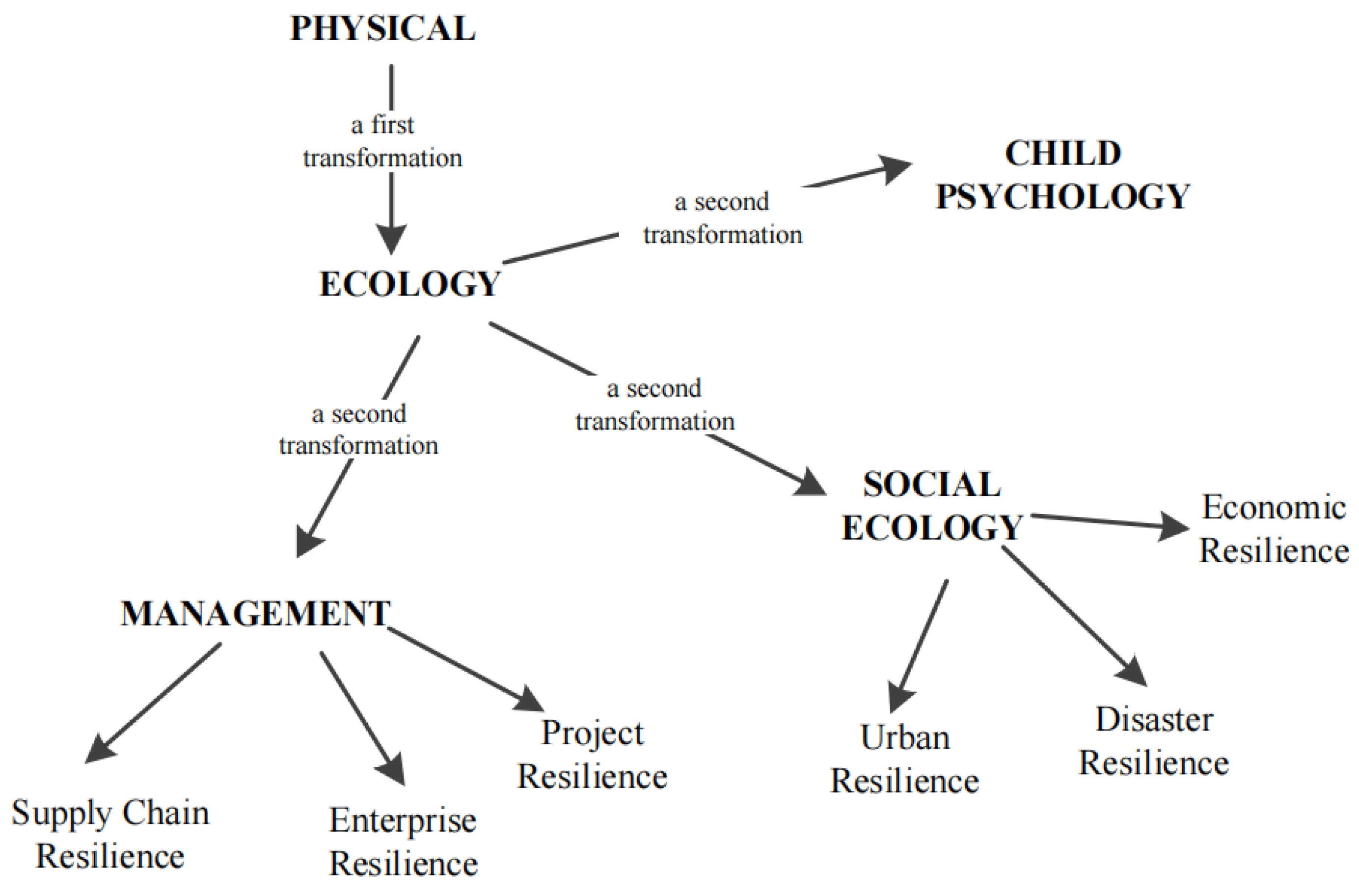
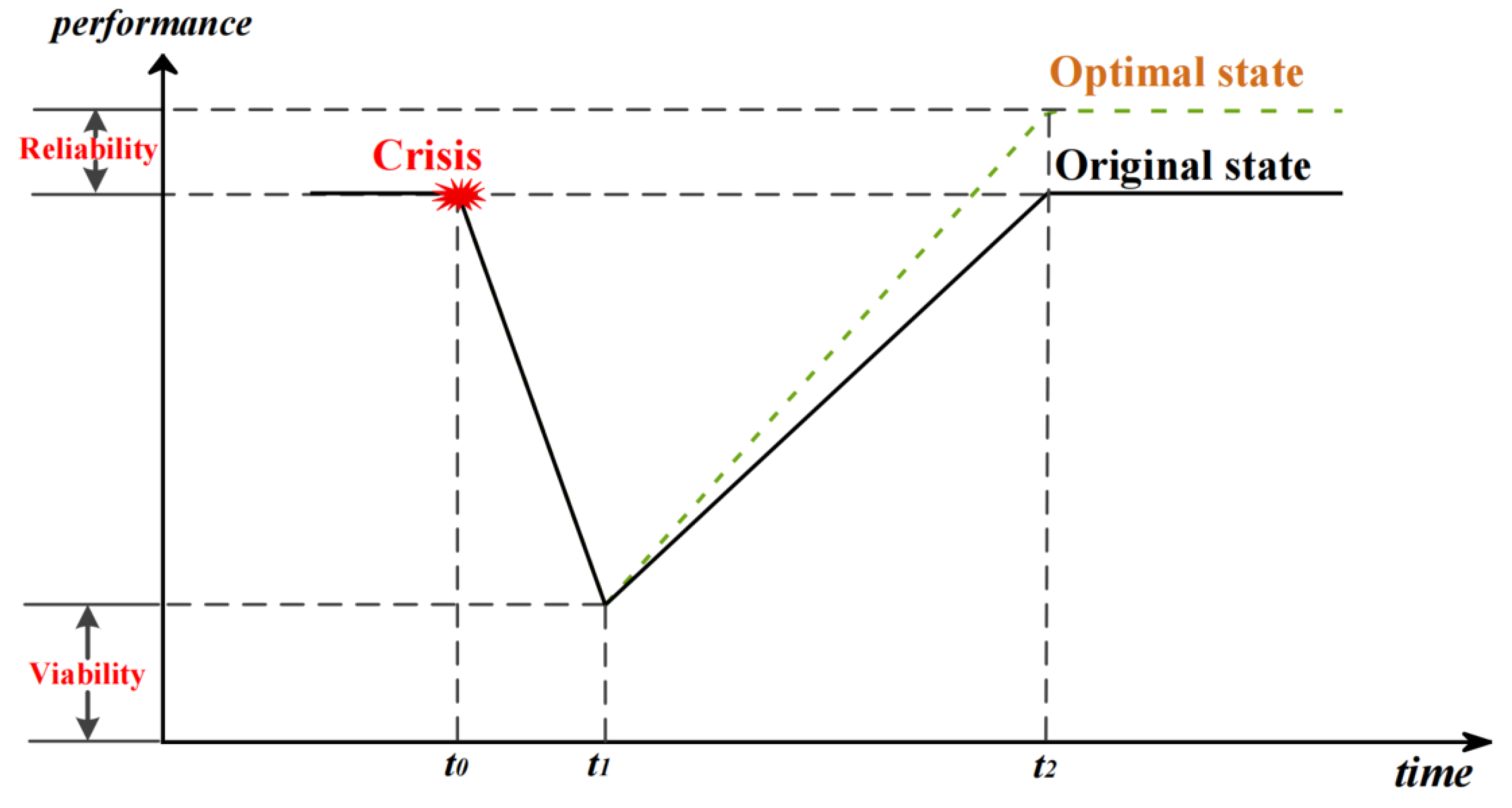
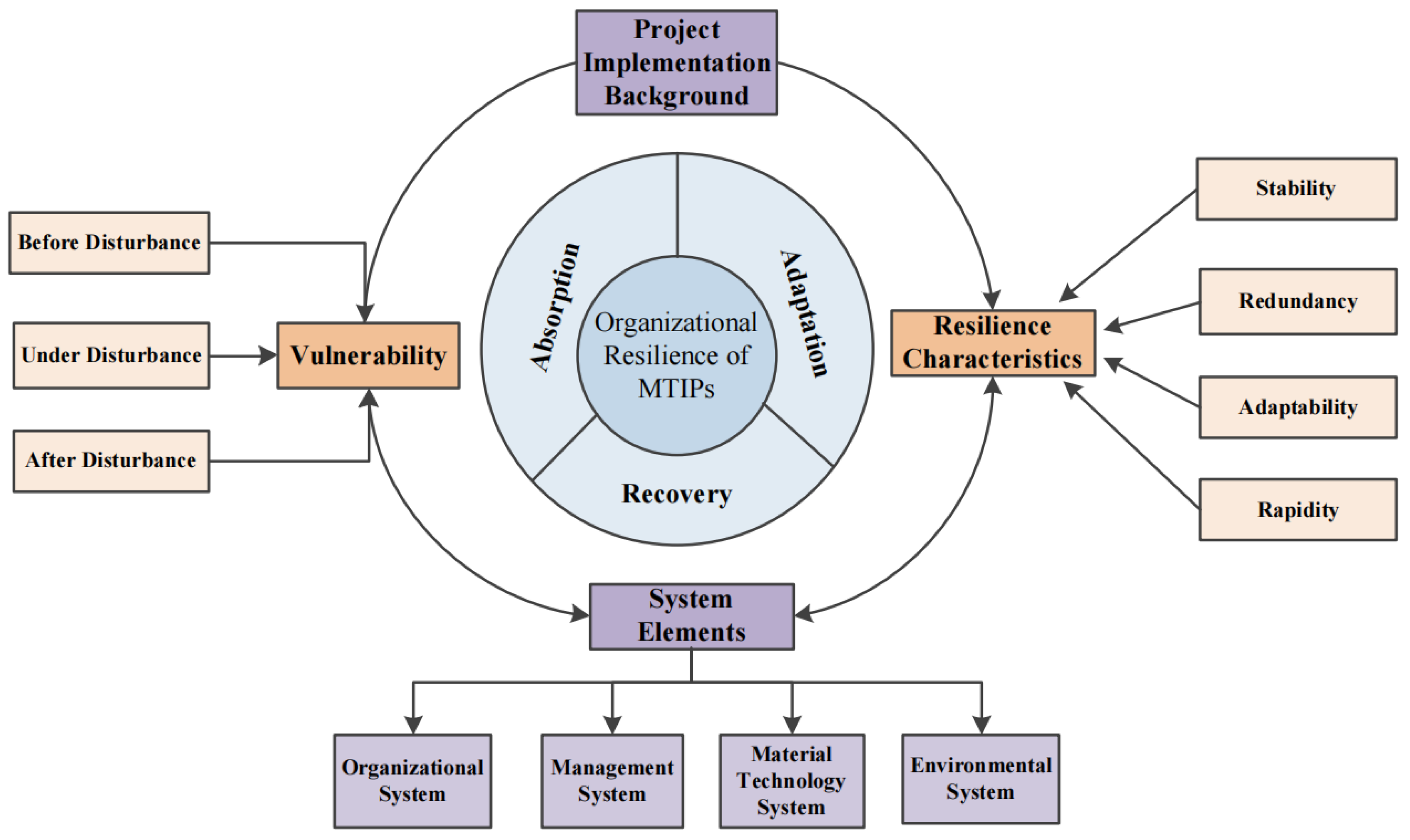
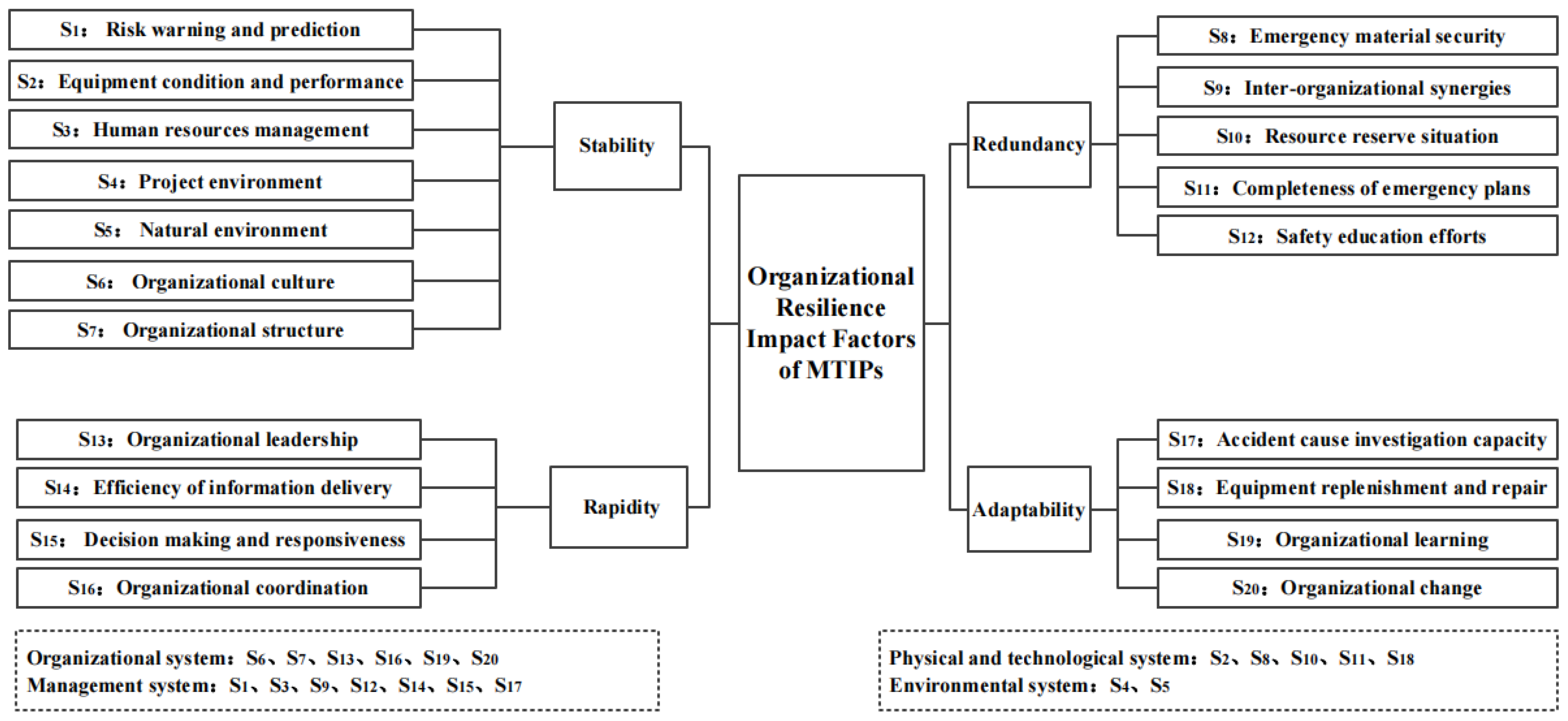



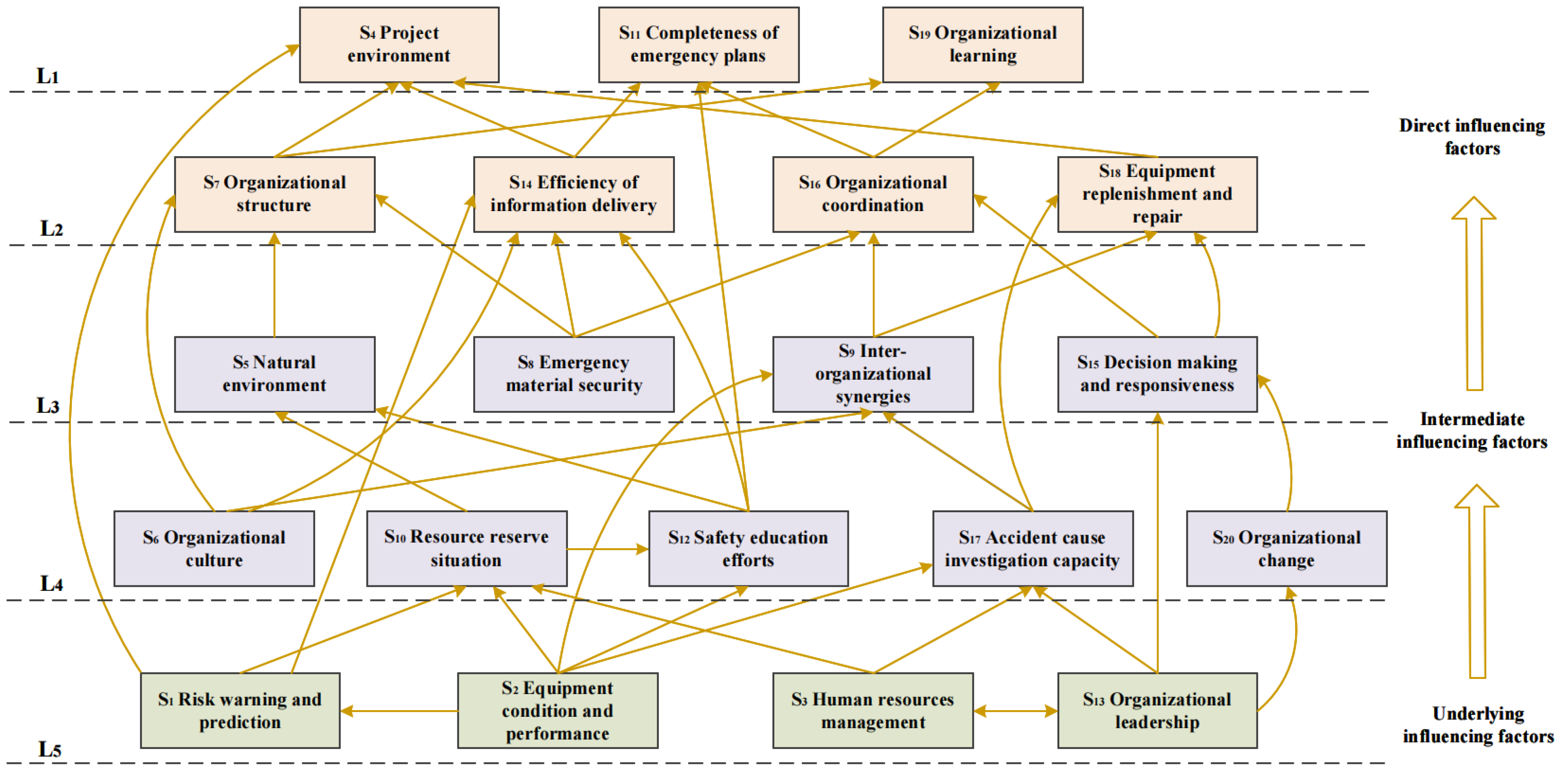
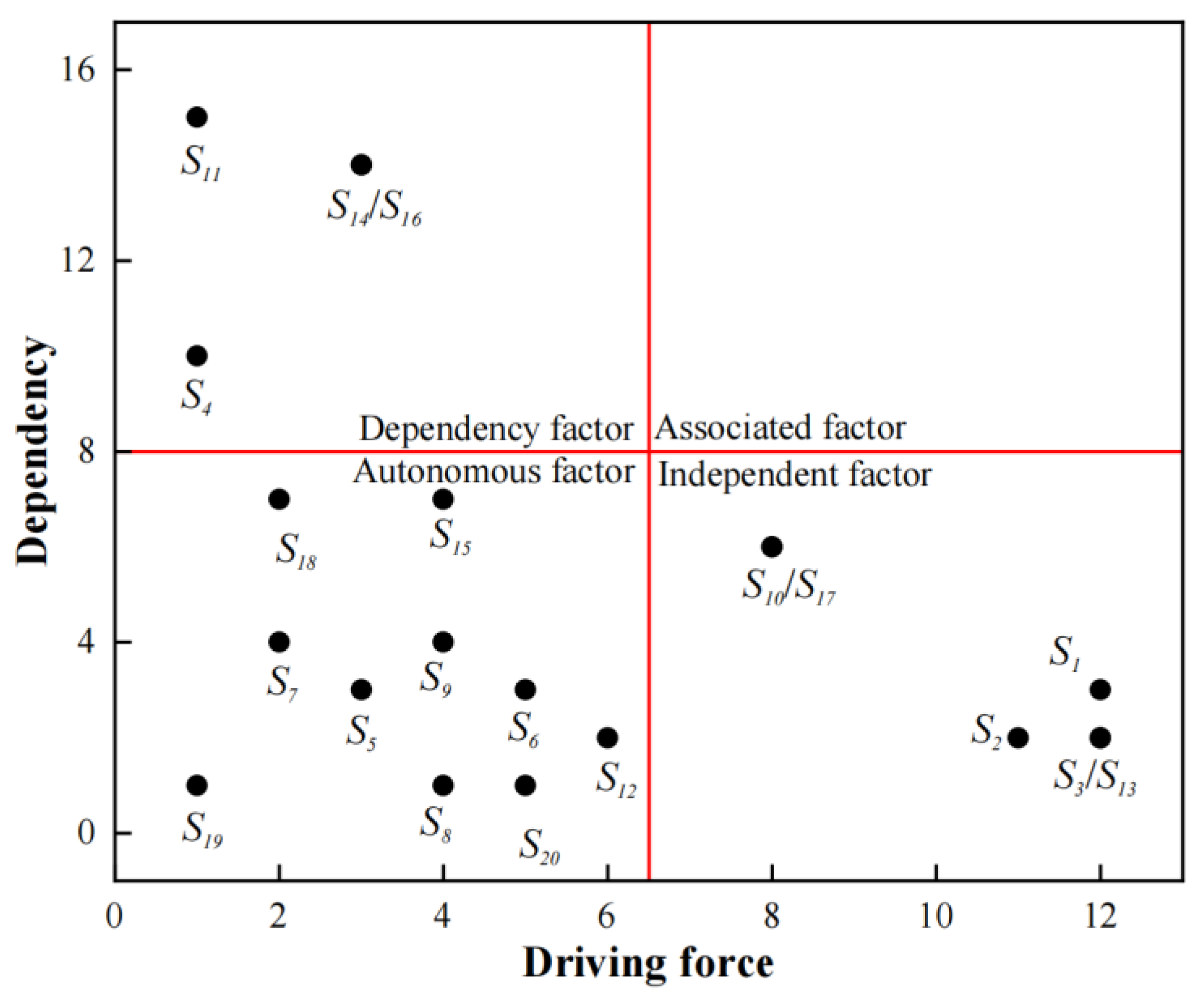
| Resilience | Definition of Resilience | Organizational Resilience Applied to MTIPs |
|---|---|---|
| Engineering resilience | The ability to restore a system’s performance level from an interrupted state to an operational state, emphasizing absorptive capacity. | Emphasis on the absorptive capacity of the project organization in the face of crisis or disruption, without consideration of the capacity to optimize learning after the crisis event is completed. |
| Ecological resilience | The ability of ecosystems to return to their original state after experiencing external disturbances, emphasizing buffering capacity [8]. | Emphasis on whether the project organization can be restored to its original state after a disruption, without consideration of the project organization’s capacity to absorb, cope and optimize. |
| Evolutionary resilience | The whole process of the dynamic response of the system, and more emphasis on the system’s ability to adapt, change and learn throughout the perturbation period [12]. | Emphasis on the capacity of the project organization to absorb, cope and optimize in the face of crisis or disruption, as a dynamic evolutionary process. |
| Classification | Distribution | Frequency | Percentage (%) |
|---|---|---|---|
| Project sector | Project construction department | 5 | 22 |
| Project technical department | 4 | 17 | |
| Project contract department | 3 | 13 | |
| Project quality department | 2 | 9 | |
| Project design department | 2 | 9 | |
| Project administration | 4 | 17 | |
| On-site construction personnel | 3 | 13 | |
| Education level | Bachelor’s degree | 15 | 65 |
| Master’s degree | 6 | 26 | |
| Doctor’s degree | 2 | 9 | |
| Working years | 4–7 years | 7 | 31 |
| 8–10 years | 12 | 52 | |
| 10–15 years | 4 | 17 |
| Semantic Variable | Score | Corresponding Triangular Fuzzy Number |
|---|---|---|
| No effect | 0 | |
| Very low effect | 1 | |
| Low effect | 2 | |
| High effect | 3 | |
| Very high effect | 4 |
| Dimension | Influencing Factor | Implications of Influencing Factors |
|---|---|---|
| Stability | S1 Risk warning and prediction | Identify and assess possible risks in advance to help the organization prepare for risks in advance. |
| S2 Equipment condition and performance | The current operation of the equipment, including normal operation, failure, maintenance and other states. | |
| S3 Human resources management | Incorporate people who possess a high degree of specialized knowledge and abilities, such as training and experience. | |
| S4 Project environment | Combination of external and internal factors affecting project implementation. | |
| S5 Natural environment | Natural disasters, force majeure and other emergencies affecting the normal operation of the project. | |
| S6 Organizational culture | The unique cultural identity of the organization includes its values, beliefs, rituals, symbols, and methods of operation. | |
| S7 Organizational structure | Sequencing, spatial location, contacts and interrelationships between departments and positions within the organization. | |
| Redundancy | S8 Emergency material security | Provision of the necessary material security for the response to and disposal of emergencies, including the procurement, storage, deployment and utilization of materials. |
| S9 Inter-organizational synergies | Capacity of group members to cooperate and communicate well in order to bring together resources and enhance one another’s abilities. | |
| S10 Resource reserve situation | Resource accumulation and reserves in advance in response to possible future needs or risks. | |
| S11 Completeness of emergency plans | In the process of formulating and implementing the contingency plan, whether the various possible situations and risks have been fully considered, and whether corresponding countermeasures have been formulated. | |
| S12 Safety education efforts | The strength and effectiveness of the organization’s investment in safety education, including the number of safety trainings, their coverage, and the quality of their content, etc. | |
| Rapidity | S13 Organizational leadership | Tasked with building trusting relationships, managing conflict, gathering and integrating knowledge, and garnering broad-based support. |
| S14 Efficiency of information delivery | The speed and accuracy with which information is transmitted within or between organizations. | |
| S15 Decision making and responsiveness | The speed with which the organization makes decisions and takes action in the face of unexpected events or emergencies. | |
| S16 Organizational coordination | Actions taken by the organization to mobilize its internal and external resources in order to withstand crises, boost productivity, and accomplish its objectives. | |
| Adaptability | S17 Accident cause investigation capacity | Ability of the organization to conduct in-depth investigations and analysis of the causes of accidents after they have occurred |
| S18 Equipment replenishment and repair | Capacity to promptly restock and fix equipment in case of malfunction or damage. | |
| S19 Organizational learning | The process by which an organization continually adapts and optimizes its structure and behavior through the acquisition of new knowledge, skills and experience in a changing environment. | |
| S20 Organizational change | Adjustments and changes in the organization’s structure, culture, strategy, etc., in order to adapt to changes in the external environment or the development of internal needs. |
| Factor | S1 | S2 | S3 | S4 | S5 | S6 | S7 | S8 | S9 | S10 | S11 | S12 | S13 | S14 | S15 | S16 | S17 | S18 | S19 | S20 |
|---|---|---|---|---|---|---|---|---|---|---|---|---|---|---|---|---|---|---|---|---|
| S1 | 0 | 0.0595 | 0.4891 | 0.2273 | 0.4891 | 0.0595 | 0.2273 | 0.8333 | 0.4891 | 0.4891 | 0.8333 | 0.2273 | 0.2273 | 0.0595 | 0.8333 | 0.0595 | 0.2273 | 0.4891 | 0 | 0.8333 |
| S2 | 0.2273 | 0 | 0.2273 | 0.2273 | 0.4891 | 0.2273 | 0.2273 | 0.8333 | 0.2273 | 0.2273 | 0 | 0.0595 | 0.2273 | 0 | 0.4891 | 0.2273 | 0.4891 | 0.0595 | 0.2273 | 0 |
| S3 | 0.4891 | 0.2273 | 0 | 0.4891 | 0.4891 | 0.4891 | 0.2273 | 0.2273 | 0.4891 | 0.2273 | 0.4891 | 0.2273 | 0.2273 | 0.4891 | 0.0595 | 0.2273 | 0.2273 | 0.0595 | 0.4891 | 0.2273 |
| S4 | 0.4891 | 0.0595 | 0.4891 | 0 | 0.0595 | 0.2273 | 0.4891 | 0.0595 | 0.2273 | 0.0595 | 0.8333 | 0.2273 | 0.8333 | 0.0595 | 0.0595 | 0.2273 | 0.0595 | 0.0595 | 0.4891 | 0.2273 |
| S5 | 0.2273 | 0.0595 | 0.4891 | 0.4891 | 0 | 0.4891 | 0.4891 | 0.0595 | 0.4891 | 0.2273 | 0.2273 | 0.4891 | 0.4891 | 0 | 0.2273 | 0.2273 | 0.0595 | 0.0595 | 0.8333 | 0.2273 |
| S6 | 0.4891 | 0.0595 | 0 | 0.4891 | 0.8333 | 0 | 0.4891 | 0.4891 | 0.4891 | 0.4891 | 0.2273 | 0.2273 | 0.4891 | 0 | 0.0595 | 0.2273 | 0.0595 | 0.2273 | 0.2273 | 0.0595 |
| S7 | 0.2273 | 0.0595 | 0.4891 | 0.4891 | 0.0595 | 0.4891 | 0 | 0.0595 | 0.2273 | 0.2273 | 0.0595 | 0.2273 | 0.4891 | 0.2273 | 0.2273 | 0.2273 | 0 | 0 | 0.2273 | 0.2273 |
| S8 | 0.4891 | 0.8333 | 0.2273 | 0.4891 | 0.2273 | 0.4891 | 0.0595 | 0 | 0.2273 | 0.8333 | 0.2273 | 0.0595 | 0.2273 | 0.2273 | 0.0595 | 0.4891 | 0.2273 | 0.2273 | 0.4891 | 0 |
| S9 | 0.2273 | 0.4891 | 0.4891 | 0.4891 | 0.4891 | 0.2273 | 0.4891 | 0.2273 | 0 | 0.4891 | 0.0595 | 0.8333 | 0.2273 | 0 | 0.4891 | 0.4891 | 0.4891 | 0.2273 | 0.2273 | 0.8333 |
| S10 | 0.8333 | 0.2273 | 0.4891 | 0.4891 | 0.0595 | 0.2273 | 0.2273 | 0.8333 | 0.2273 | 0 | 0.2273 | 0.0595 | 0.4891 | 0.2273 | 0.8333 | 0.2273 | 0.2273 | 0.2273 | 0.4891 | 0.8333 |
| S11 | 0.2273 | 0.0595 | 0.2273 | 0.4891 | 0.2273 | 0.0595 | 0.0595 | 0 | 0.2273 | 0.0595 | 0 | 0.4891 | 0.4891 | 0.2273 | 0.2273 | 0.0595 | 0 | 0.2273 | 0.4891 | 0.4891 |
| S12 | 0.4891 | 0.0595 | 0.4891 | 0.8333 | 0.2273 | 0.2273 | 0.2273 | 0.0595 | 0.4891 | 0.2273 | 0.2273 | 0 | 0.2273 | 0.2273 | 0.2273 | 0.0595 | 0 | 0.0595 | 0.8333 | 0.8333 |
| S13 | 0.2273 | 0.2273 | 0.4891 | 0.4891 | 0.2273 | 0.2273 | 0.4891 | 0.2273 | 0.4891 | 0.4891 | 0.2273 | 0.2273 | 0 | 0.4891 | 0.2273 | 0.4891 | 0.2273 | 0.2273 | 0.4891 | 0.0595 |
| S14 | 0.8333 | 0.0595 | 0.8333 | 0.2273 | 0.4891 | 0.4891 | 0.4891 | 0.2273 | 0.2273 | 0.2273 | 0.4891 | 0.2273 | 0.4891 | 0 | 0.8333 | 0.4891 | 0.2273 | 0.4891 | 0 | 0.2273 |
| S15 | 0.2273 | 0.0595 | 0.2273 | 0.0595 | 0.2273 | 0.0595 | 0.4891 | 0.0595 | 0.4891 | 0.2273 | 0.0595 | 0.4891 | 0.4891 | 0.0595 | 0 | 0.0595 | 0.0595 | 0.2273 | 0.4891 | 0.8333 |
| S16 | 0.2273 | 0.2273 | 0.8333 | 0.4891 | 0.4891 | 0.2273 | 0.4891 | 0.4891 | 0.2273 | 0.4891 | 0.2273 | 0.2273 | 0.4891 | 0.0595 | 0.2273 | 0 | 0 | 0.0595 | 0.8333 | 0.2273 |
| S17 | 0.2273 | 0.2273 | 0.0595 | 0.2273 | 0.0595 | 0.2273 | 0 | 0.2273 | 0 | 0.4891 | 0.2273 | 0 | 0.2273 | 0.2273 | 0.8333 | 0.2273 | 0 | 0.2273 | 0.4891 | 0.0595 |
| S18 | 0.8333 | 0.4891 | 0.2273 | 0.4891 | 0.0595 | 0.2273 | 0.2273 | 0.4891 | 0.2273 | 0.2273 | 0.2273 | 0.2273 | 0.0595 | 0.2273 | 0.4891 | 0.0595 | 0.4891 | 0 | 0.8333 | 0.0595 |
| S19 | 0.2273 | 0 | 0.4891 | 0.4891 | 0.2273 | 0.4891 | 0.2273 | 0.4891 | 0.0595 | 0.2273 | 0.4891 | 0.2273 | 0.4891 | 0 | 0.2273 | 0.2273 | 0.2273 | 0.2273 | 0 | 0.2273 |
| S20 | 0.4891 | 0.0595 | 0.8333 | 0.2273 | 0.2273 | 0.0595 | 0.4891 | 0.0595 | 0.4891 | 0.4891 | 0.8333 | 0.2273 | 0.4891 | 0.0595 | 0.2273 | 0.2273 | 0.0595 | 0.2273 | 0.4891 | 0 |
| Factor | Order of Centrality | Factor Properties | ||||
|---|---|---|---|---|---|---|
| S1 | 4.188 | 4.375 | 8.563 | −0.187 | 1 | Effect factor |
| S2 | 2.736 | 2.024 | 4.759 | 0.712 | 19 | Cause factor |
| S3 | 3.616 | 4.788 | 8.404 | −1.173 | 2 | Effect factor |
| S4 | 3.039 | 4.658 | 7.697 | −1.619 | 8 | Effect factor |
| S5 | 3.426 | 3.286 | 6.712 | 0.14 | 10 | Cause factor |
| S6 | 3.387 | 3.078 | 6.465 | 0.309 | 15 | Cause factor |
| S7 | 2.582 | 3.642 | 6.224 | −1.06 | 17 | Effect factor |
| S8 | 3.641 | 3.406 | 7.047 | 0.235 | 9 | Cause factor |
| S9 | 4.337 | 3.662 | 7.998 | 0.675 | 6 | Cause factor |
| S10 | 4.4 | 3.735 | 8.135 | 0.665 | 4 | Cause factor |
| S11 | 2.607 | 3.919 | 6.525 | −1.312 | 13 | Effect factor |
| S12 | 3.592 | 3.057 | 6.648 | 0.535 | 12 | Cause factor |
| S13 | 3.725 | 4.451 | 8.176 | −0.726 | 3 | Effect factor |
| S14 | 4.454 | 1.783 | 6.237 | 2.671 | 16 | Cause factor |
| S15 | 2.951 | 3.737 | 6.688 | −0.786 | 11 | Effect factor |
| S16 | 3.83 | 2.676 | 6.506 | 1.154 | 14 | Cause factor |
| S17 | 2.509 | 1.922 | 4.431 | 0.587 | 20 | Cause factor |
| S18 | 3.558 | 2.142 | 5.7 | 1.415 | 18 | Cause factor |
| S19 | 3.064 | 4.978 | 8.042 | −1.914 | 5 | Effect factor |
| S20 | 3.695 | 4.017 | 7.712 | −0.323 | 7 | Effect factor |
| Factor | S1 | S2 | S3 | S4 | S5 | S6 | S7 | S8 | S9 | S10 | S11 | S12 | S13 | S14 | S15 | S16 | S17 | S18 | S19 | S20 |
|---|---|---|---|---|---|---|---|---|---|---|---|---|---|---|---|---|---|---|---|---|
| S1 | 1 | 1 | 0 | 1 | 0 | 1 | 0 | 0 | 0 | 1 | 1 | 1 | 0 | 1 | 1 | 1 | 1 | 1 | 0 | 0 |
| S2 | 1 | 1 | 0 | 1 | 0 | 1 | 0 | 0 | 0 | 1 | 1 | 0 | 0 | 1 | 1 | 1 | 1 | 1 | 0 | 0 |
| S3 | 0 | 0 | 1 | 1 | 1 | 0 | 1 | 0 | 0 | 1 | 1 | 0 | 1 | 1 | 1 | 1 | 1 | 1 | 0 | 0 |
| S4 | 0 | 0 | 0 | 1 | 0 | 0 | 0 | 0 | 0 | 0 | 0 | 0 | 0 | 0 | 0 | 0 | 0 | 0 | 0 | 0 |
| S5 | 0 | 0 | 0 | 1 | 1 | 0 | 1 | 0 | 0 | 0 | 0 | 0 | 0 | 0 | 0 | 0 | 0 | 0 | 0 | 0 |
| S6 | 0 | 0 | 0 | 0 | 0 | 1 | 0 | 0 | 1 | 0 | 1 | 0 | 0 | 1 | 0 | 1 | 0 | 0 | 0 | 0 |
| S7 | 0 | 0 | 0 | 1 | 0 | 0 | 1 | 0 | 0 | 0 | 0 | 0 | 0 | 0 | 0 | 0 | 0 | 0 | 0 | 0 |
| S8 | 0 | 0 | 0 | 0 | 0 | 0 | 0 | 1 | 0 | 0 | 1 | 0 | 0 | 1 | 0 | 1 | 0 | 0 | 0 | 0 |
| S9 | 0 | 0 | 0 | 0 | 0 | 0 | 0 | 0 | 1 | 0 | 1 | 0 | 0 | 1 | 0 | 1 | 0 | 0 | 0 | 0 |
| S10 | 0 | 0 | 0 | 1 | 0 | 0 | 0 | 0 | 0 | 1 | 1 | 0 | 0 | 1 | 1 | 1 | 1 | 1 | 0 | 0 |
| S11 | 0 | 0 | 0 | 0 | 0 | 0 | 0 | 0 | 0 | 0 | 1 | 0 | 0 | 0 | 0 | 0 | 0 | 0 | 0 | 0 |
| S12 | 1 | 0 | 0 | 0 | 0 | 0 | 0 | 0 | 1 | 0 | 1 | 1 | 0 | 1 | 0 | 1 | 0 | 0 | 0 | 0 |
| S13 | 0 | 0 | 1 | 1 | 1 | 0 | 1 | 0 | 0 | 1 | 1 | 0 | 1 | 1 | 1 | 1 | 1 | 1 | 0 | 0 |
| S14 | 0 | 0 | 0 | 0 | 0 | 0 | 0 | 0 | 0 | 0 | 1 | 0 | 0 | 1 | 0 | 1 | 0 | 0 | 0 | 0 |
| S15 | 0 | 0 | 0 | 0 | 0 | 0 | 0 | 0 | 0 | 0 | 1 | 0 | 0 | 1 | 1 | 1 | 0 | 0 | 0 | 0 |
| S16 | 0 | 0 | 0 | 0 | 0 | 0 | 0 | 0 | 0 | 0 | 1 | 0 | 0 | 1 | 0 | 1 | 0 | 0 | 0 | 0 |
| S17 | 0 | 0 | 0 | 1 | 0 | 0 | 0 | 0 | 0 | 1 | 1 | 0 | 0 | 1 | 1 | 1 | 1 | 1 | 0 | 0 |
| S18 | 0 | 0 | 0 | 1 | 0 | 0 | 0 | 0 | 0 | 0 | 0 | 0 | 0 | 0 | 0 | 0 | 0 | 1 | 0 | 0 |
| S19 | 0 | 0 | 0 | 0 | 0 | 0 | 0 | 0 | 0 | 0 | 0 | 0 | 0 | 0 | 0 | 0 | 0 | 0 | 1 | 0 |
| S20 | 0 | 0 | 0 | 0 | 0 | 0 | 0 | 0 | 1 | 0 | 1 | 0 | 0 | 1 | 0 | 1 | 0 | 0 | 0 | 1 |
| Factor | Reachable Set | Prior Set | Intersection Set |
|---|---|---|---|
| S1 | 1,2,4,6,10,11,12,14,15,16,17,18 | 1,2,12 | 1,2,12 |
| S2 | 1,2,4,6,10,11,14,15,16,17,18 | 1,2 | 1,2 |
| S3 | 3,4,5,7,10,11,13,14,15,16,17,18 | 3,13 | 3,13 |
| S4 | 4 | 1,2,3,4,5,7,10,13,17,18 | 4 |
| S5 | 4,5,7 | 3,5,13 | 5 |
| S6 | 6,9,11,14,16 | 1,2,6 | 6 |
| S7 | 4,7 | 3,5,7,13 | 7 |
| S8 | 8,11,14,16 | 8 | 8 |
| S9 | 9,11,14,16 | 6,9,12,20 | 9 |
| S10 | 4,10,11,14,15,16,17,18 | 1,2,3,10,13,17 | 17,10 |
| S11 | 11 | 1,2,3,6,8,9,10,11,12,13,14,15,16,17,20 | 11 |
| S12 | 1,9,11,12,14,16 | 1,12 | 1,12 |
| S13 | 3,4,5,7,10,11,13,14,15,16,17,18 | 3,13 | 3,13 |
| S14 | 11,14,16 | 1,2,3,6,8,9,10,12,13,14,15,16,17,20 | 16,14 |
| S15 | 11,14,15,16 | 1,2,3,10,13,15,17 | 15 |
| S16 | 11,14,16 | 1,2,3,6,8,9,10,12,13,14,15,16,17,20 | 16,14 |
| S17 | 4,10,11,14,15,16,17,18 | 1,2,3,10,13,17 | 17,10 |
| S18 | 4,18 | 1,2,3,10,13,17,18 | 18 |
| S19 | 19 | 19 | 19 |
| S20 | 9,11,14,16,20 | 20 | 20 |
| Factor | Driving Force | Dependency |
|---|---|---|
| S1 | 12 | 3 |
| S2 | 11 | 2 |
| S3 | 12 | 2 |
| S4 | 1 | 10 |
| S5 | 3 | 3 |
| S6 | 5 | 3 |
| S7 | 2 | 4 |
| S8 | 4 | 1 |
| S9 | 4 | 4 |
| S10 | 8 | 6 |
| S11 | 1 | 15 |
| S12 | 6 | 2 |
| S13 | 12 | 2 |
| S14 | 3 | 14 |
| S15 | 4 | 7 |
| S16 | 3 | 14 |
| S17 | 8 | 6 |
| S18 | 2 | 7 |
| S19 | 1 | 1 |
| S20 | 5 | 1 |
Disclaimer/Publisher’s Note: The statements, opinions and data contained in all publications are solely those of the individual author(s) and contributor(s) and not of MDPI and/or the editor(s). MDPI and/or the editor(s) disclaim responsibility for any injury to people or property resulting from any ideas, methods, instructions or products referred to in the content. |
© 2024 by the authors. Licensee MDPI, Basel, Switzerland. This article is an open access article distributed under the terms and conditions of the Creative Commons Attribution (CC BY) license (https://creativecommons.org/licenses/by/4.0/).
Share and Cite
Liu, W.; Hu, Y.; Huang, Q. Research on Critical Factors Influencing Organizational Resilience of Major Transportation Infrastructure Projects: A Hybrid Fuzzy DEMATEL-ISM-MICMAC Approach. Buildings 2024, 14, 1598. https://doi.org/10.3390/buildings14061598
Liu W, Hu Y, Huang Q. Research on Critical Factors Influencing Organizational Resilience of Major Transportation Infrastructure Projects: A Hybrid Fuzzy DEMATEL-ISM-MICMAC Approach. Buildings. 2024; 14(6):1598. https://doi.org/10.3390/buildings14061598
Chicago/Turabian StyleLiu, Wei, Yuehan Hu, and Qingcheng Huang. 2024. "Research on Critical Factors Influencing Organizational Resilience of Major Transportation Infrastructure Projects: A Hybrid Fuzzy DEMATEL-ISM-MICMAC Approach" Buildings 14, no. 6: 1598. https://doi.org/10.3390/buildings14061598




